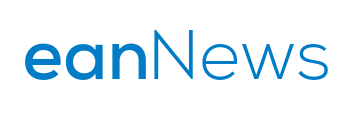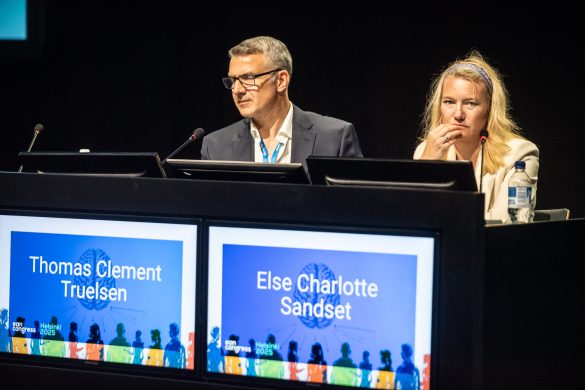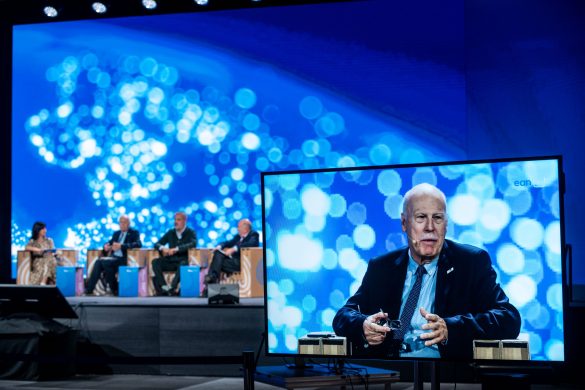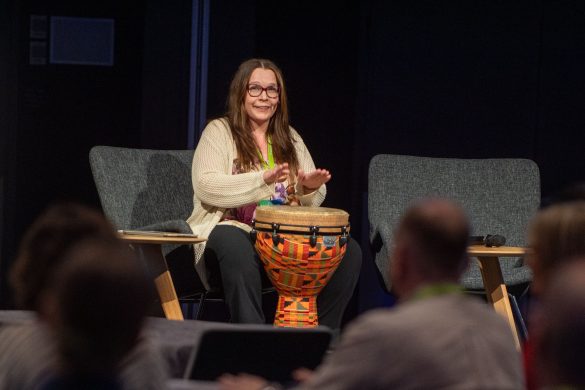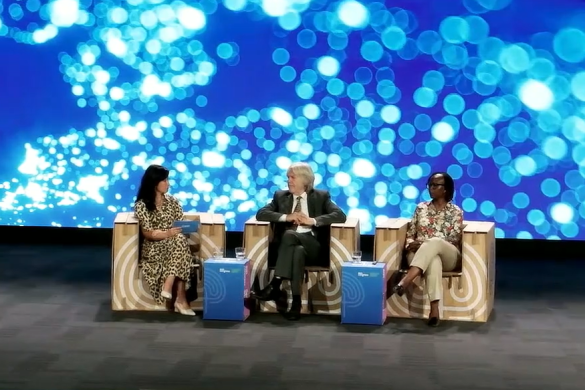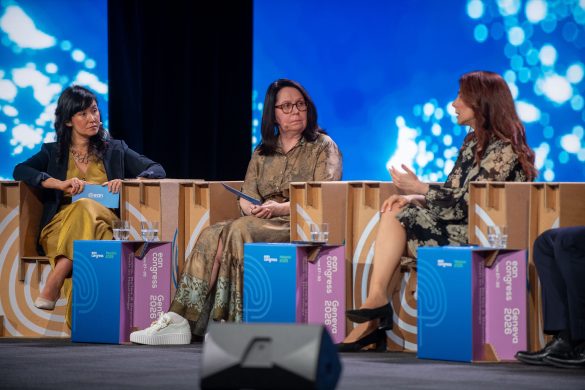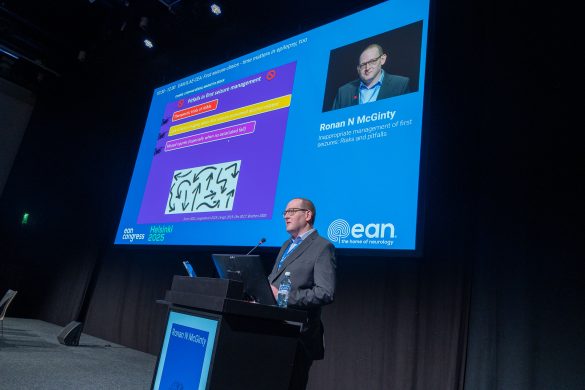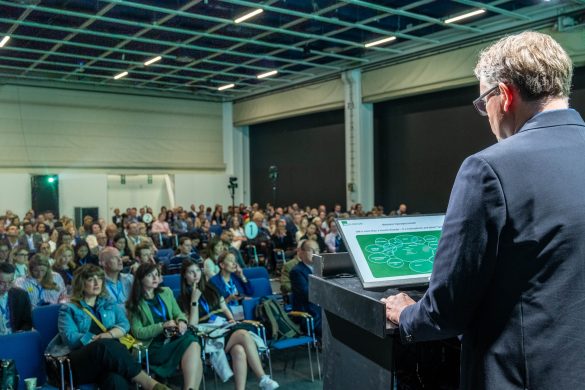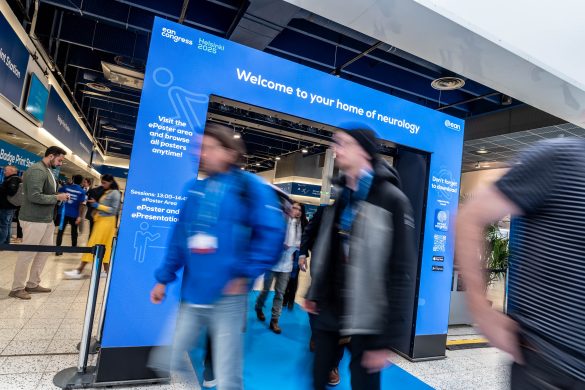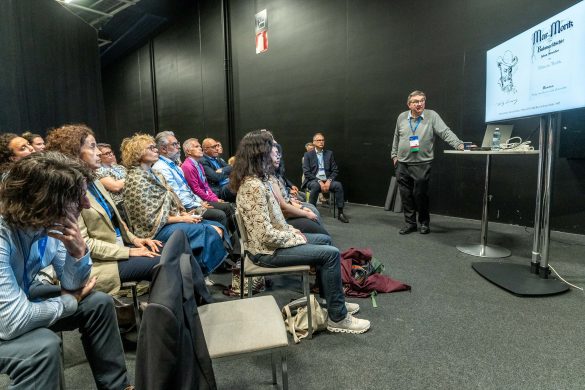
Benedetta Bodini
This interesting session covering the updates on acute stroke treatments started with a lecture by Dr Sandset from Norway. She discussed the latest evidence for on- and off-label treatment in intravenous thrombolysis, and started her lecture by reminding us that all the evidence indicates that time is critical in the treatment of stroke. First, the results of the recent WAKE UP trial were discussed, in which it was demonstrated that treatment with intravenous alteplase was associated with a favourable outcome in patients with stroke with an unknown time of onset in the presence of MRI features suggesting recent cerebral infarction. MRI is not always rapidly available in thrombolysing centres, but recent data from a meta-analysis suggest beneficial effects of intravenous thrombolysis even in patients with stroke with an unknown time of onset selected based on CT imaging appearances. Dr Sandset then focused on the debate on whether patients with mild or rapidly improving symptoms should be considered for intravenous thrombolysis. While no conclusive results from the PRISMS trial comparing alteplase versus aspirin in patients with stroke and mild symptoms are available, due to its early termination, data from a very recent observational study have provided some indication that it might be reasonable to treat these patients with intravenous thrombolysis. Dr Sandset then moved on to discussing the role of microbleeds as a risk factor for symptomatic intracranial hemorrhage following thrombolysis. Consistent data indicate that the presence of more than 10 cerebral microbleeds on pre-treatment MRI scans, particularly if localised in lobar locations, should be considered a risk factor for intracranial hemorrhage after thrombolysis. The following part of the lecture focused on blood pressure control and risk of intracranial hemorrhage after thrombolysis. Dr Sandset discussed the data from the recent study ENCHANTED which, despite not finding a difference in clinical outcome between an intensive blood pressure lowering group and a standard guideline-recommended blood pressure lowering group, at 90 days after thrombolysis, there was a reduction in intracranial hemorrhage in the intensive blood pressure lowering group. The final part of the lecture covered the current knowledge on intravenous thrombolysis in patients taking oral anticoagulant treatment. Dr Sandset presented data from a recent meta-analysis indicating that no significant increased risk of haemorrhage seems to be associated with treatment with oral anticoagulants.
In the second lecture of the session, Dr Puy from France presented an update on the treatment of intracranial hemorrhage, which is a very severe condition associated with a mortality of 50%. Dr Puy underlined that timing in the treatment of intracranial hemorrhage is crucial and moved on to discuss the four main therapeutic pathophysiological targets which are expansion of haemorrhage, intraventricular hemorrhage, peri-haematomal oedema and secondary brain tissue damage. The first therapeutic decision to be taken in order to maximise chances of a good outcome is immediate admission to a stroke unit. To counteract expansion of intracerebral hemorrhage, one effective tool is blood pressure lowering. Data from the INTERACT 2 and the ATACH 2 trials, taken together, suggest a benefit of blood pressure lowering aiming for a target of between 140 and 130 mmHg, but with a lower limit of 120 mmHg to prevent hypoperfusion and adverse events. Correcting haemostasis is also crucial, through immediate suspension of any anticoagulant treatment and administration of reversal treatments in this context. Dr Puy presented the results of the TICH-2 study which showed that treatment with tranexamic acid was able to reduce haematoma growth and early mortality. The second part of the lecture covered surgical approaches to evacuate intracranial hematoma. Craniectomy is generally not recommended, while the ongoing SWITCH trial may provide some clarity in regard to the role of decompressive hemicraniectomy without associated blood evacuation procedures. Dr Puy suggested that, in the next decade, minimally invasive procedures are likely be further developed and employed, such as the combined use of a microcatheter with rtPA infusion, even though the recent MISTIE trial employing this approach failed to demonstrate a benefit for patients. To conclude the surgical section of his lecture, Dr Puy underlined that intracranial hemorrhage is not a neurosurgical emergency, and that the decision to operate or not should be collegiate but may be optimally led by neurologists. Unfortunately, there is currently no evidence to support any specific treatment to reduce peri-haematomal edema. Dr Puy concluded by describing novel potentially neuroprotective molecules active on the different pathways leading to tissue damage, such as molecules able to reduce thrombin toxicity or neuronal excitotoxicity. Unfortunately, all these molecules have, to date, failed to demonstrate any benefit when applied to humans, and neuroprotection remains one of the key challenges of the next decade in the treatment of intracranial hemorrhage.
In the final lecture of this session, Dr Caso from Italy discussed the interesting issue of restarting anti-thrombotic agents after a cardioembolic ischaemic stroke. We know that, in patients with atrial fibrillation, the risk of recurrent events is very high especially in the first hours and over the first two days after a stroke. At the same time, the risk of haemorrhagic transformation is also very high in patients following cardioembolic stroke. Balancing these conflicting risk-benefit ratios, the best time-window to start anticoagulants has been estimated to range from 4 to 12 days. The ESO guidelines on restarting anticoagulation after cardioembolic stroke due to non-valvular atrial fibrillation highlight the relevance of lesion size: for mild strokes and small infarcts (<1.5 cm), it is considered reasonable to start anticoagulation at day 3-4 after stroke; for larger infarcts, anticoagulant treatment might be delayed until 14 days after the ischaemic event. Dr Caso then described the design of four ongoing trials in which the objective is to assess the use of early or delayed anticoagulation with novel oral anticoagulants in patients with previous ischaemic stroke and atrial fibrillation: ELAN, OPTIMAS, TIMING, and START. The results of these studies, which are expected between 2021 and early 2022, will be key to informing new guidelines for the restart of antithrombotic treatments after cardioembolic ischaemic stroke due to atrial fibrillation. The second topic discussed was when to restart antithrombotic agents after an intracranial haemorrhage. Dr Caso presented recent data indicating that, after an intracranial haemorrhage, patients on anticoagulant treatments have a much higher risk of an ischaemic recurrence than of a recurrent intracerebral hemorrhage. Most data in the literature have been collected from patients with valve replacement, in whom anticoagulation should be restarted as soon as possible, between 10 and 11 days from the event. Dr Caso presented data supporting the notion that, in order to balance the risk of bleeding with that of ischaemic events after an intracerebral hemorrhage, the best time to reintroduce anticoagulants in non-valve replacement patients is around 10 weeks after the intracerebral haemorrhage. Recent European Society of Cardiology Guidelines provide similar recommendations, suggesting a reintroduction of oral anticoagulant treatments after 4-8 weeks from an intracerebral hemorrage. As a final remark, it was underlined that newer oral anticoagulant treatments offer several advantages over vitamin K antagonists both in ischaemic and haemorrhagic events.
